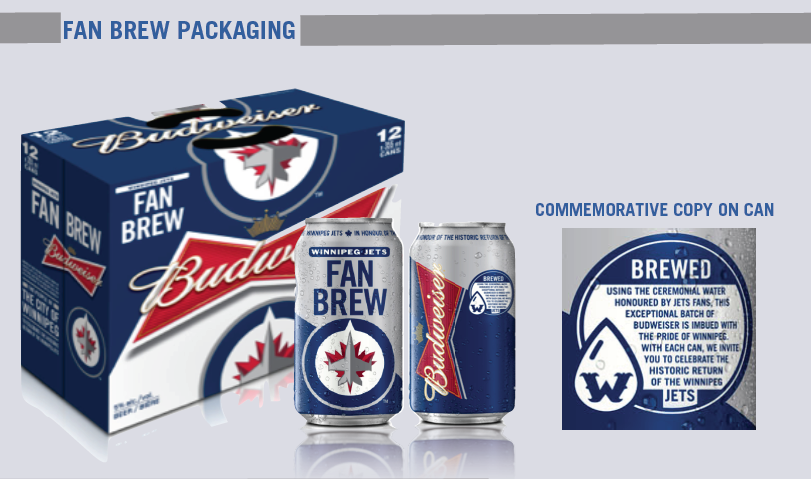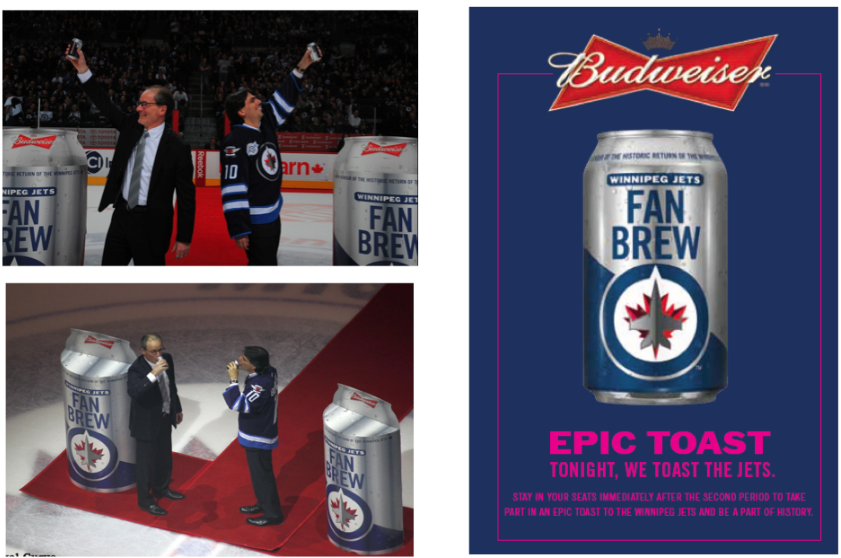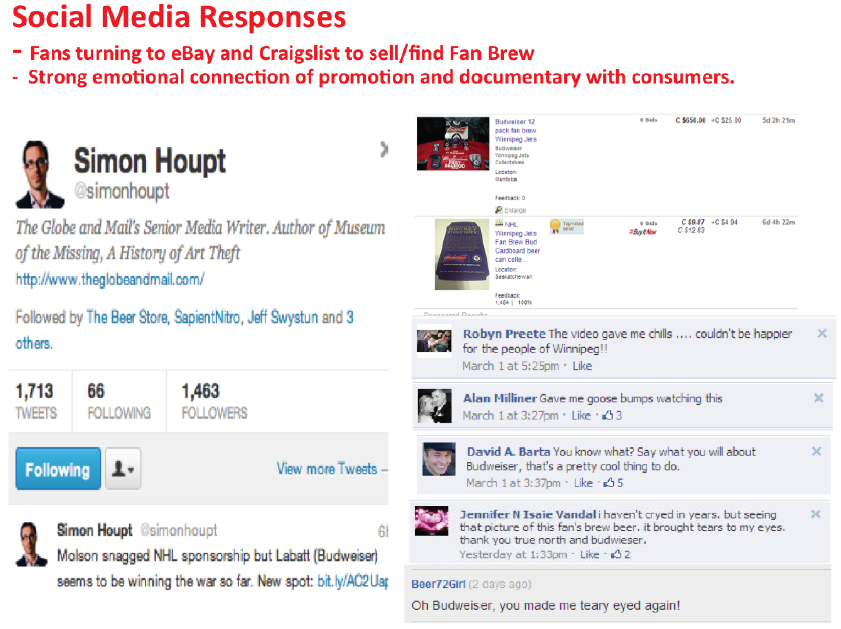Budweiser Fan Brew
Events, Seasonal and Short-Term (GOLD)
Client Credits: Budweiser
Jorn Socquet, VP of Marketing
Kyle Norrington, Marketing Director
Ben Seaton, Marketing Manager
Andrew Oosterhuis, Marketing Manager
Agency Credits: Anomaly
Mike Byrne, Executive Creative Director
Paul Renner, Creative Director
Derek Barnes, Creative Director
Grant Mason, Art Director
Jessica Ghersi, Copywriter
John Legere, Producer
Jason DeLand, Business Director
Derek McCarty, Account Director
Crossover Notes:
All winning cases contain lessons that cross over from one case to another. David Rutherford has been identifying these as Crossover Notes since CASSIES 1997. The full set for CASSIES 2013 can be downloaded from the Case Library section at www.cassies.ca.
Crossover Note 2. Brand Truths.
Crossover Note 6. Should the product be improved?
Crossover Note 8. Classic Rivalries.
Crossover Note 10. Conventional Wisdom—should it be challenged?
Crossover Note 12. Changing the Goalposts.
To see creative, click on the links that are embedded in the case.
Section I — BASIC INFORMATION
| Business Results Period (Consecutive Months): | Month of March, 2012 |
| Start of Advertising/Communication Effort: | March 1, 2012 |
| Base Period as a Benchmark: | March 2011 |
Section II — SITUATION ANALYSIS
a) Overall Assessment
In 2010 Budweiser had identified hockey as a key strategic priority and was ready to win with consumers, armed with the NHL sponsorship forming a part of this plan. However, in 2011, after a single year of being the lead Labatt brand for the NHL sponsorship, Labatt found itself outbid for the Canadian NHL league sponsorship rights by Molson Coors. Budweiser found itself in a position where Molson, with its lead brand Molson Canadian, would have several key team sponsorships, which it had held for many years, as well as the league partnership, all of which contributed to a much higher brand association between Molson Canadian and hockey than Budweiser had enjoyed.
At a more regional level, there had been no hockey team in Manitoba or Saskatchewan since the Winnipeg Jets had been moved to Phoenix in the mid-1990s. For Budweiser at a local level, this meant that only NHL games from other markets (most with Molson advertising and sponsorship) came in over television.
In October of 2011, professional hockey returned to Winnipeg after a fifteen-year absence, putting a seventh Canadian team back into the league. All of Canada was excited. Despite losing the NHL league sponsorship, Budweiser was successful in its bid for the sponsorship rights to the Winnipeg Jets. This was a great victory for Budweiser, but one that came with geographic limitations on activation (NHL rules limit team activation to a 75km radius surrounding the arena). As such, it appeared that Budweiser’s power to connect to fans in Manitoba could be limited to that local area.
The key quandary that needed to be addressed was: how could Budweiser sell enough beer to pay for their investment in the Winnipeg sponsorship, build regional preference in the Prairies, and contribute to the goal of driving awareness of Budweiser’s association with hockey in general (all while being under such tight geographic restrictions)?
In short, how could Budweiser defy conventional wisdom and beat out the voice of Molson’s new national NHL sponsorship with a local one? [Crossover Note 10]
b) Resulting Business Objectives
Budweiser’s sales goals were both local and regional but also included a contribution to awareness of Budweiser’s association with hockey.
The local goals were simple: (i) sell enough Budweiser in the first year to show sales velocity, proving to retailers that Budweiser was worth their support and demonstrate that Budweiser could use the Winnipeg Jets sponsorship to increase sales; and (ii) on a regional level improve top 3 favourite brand preference as a key to longer-term sales success. Nationally, Budweiser wanted to support its broader activation around the sport of hockey. Therefore, a goal of earned media impressions was important to extending the impact and reach of the activity.
Core Business Objectives
1. Increase local sales (in Winnipeg) by 5% YTY
2. Increase Budweiser’s market share by 1pt vs. year ago (vs. year ago in Manitoba)
Core Communication Objectives
1. Increase top 3 favourite brand preference in the Prairies by 1.5 percentage points over a twelve month period.
2. Target 5MM earned media impressions.
c) Annual Media Budget
$100,000 – $200,000
d) Geographic Area
Program was launched in the heart of Winnipeg and limited to a 75km radius around the city.
Section III — STRATEGIC THINKING
a) Analysis and Insight
We learned through extensive secondary research and qualitative groups conducted by IPSOS that consumers prefer brands that enrich their relationship with a sport (versus brands that just slap their logos on ads and signage). To break through we needed to engage fans and connect them to the team. [Crossover Note 2]
Ensuring the fan base was engaged wasn’t the only challenge Budweiser faced, we had the problem of limited geography working against us as well. As such, Budweiser needed an activation that was both incredibly local in scope for loyal Winnipeg Jets fans, but with a story that would be interesting enough to break through and travel where traditional advertising could not – outside of Winnipeg, onto the Prairies, and across Canada. [Crossover Note 12] Meanwhile Budweiser could differentiate itself from Molson Canadian, especially if they continued to rely on traditional advertising with their NHL sponsorship.[Crossover Note 8]
The solution? Budweiser would brew the first beer made from the dreams and hopes of hockey fans, selling celebration and optimism in a can. Those who could buy, did.
b) Communication Strategy
Winnipeg Jets fans had waited fifteen years for their team to return. But what we discovered was that they had not spent those fifteen years idle. Their team might have left town, but they had stayed loyal and vowed to build a city that would have the financial health to support an NHL franchise. In interviews all across Winnipeg we discovered that the return of the Jets was not just a hockey moment, but a civic moment: a triumph of a city that had lost its most treasured institution but had vowed to get it back.
Given this history, when constructing a communications strategy to promote a story and a product for hockey in Winnipeg Budweiser started with the fans – for the real victory in the first year back for the Jets was not the players’, but the fans’. The puck would drop on ice in an arena built from fifteen years of fans’ blood, sweat, and tears needed to build up Winnipeg’s economy.
Our idea was to make the metaphor real – Budweiser wanted the rink ice to include water that came from the city of Winnipeg and from its fans. To do this, we captured water from all three rivers surrounding Winnipeg and toured them in glass vessels around the city, encouraging fans (not players) to touch, hug, speak to and otherwise honour the water within.
Team President Jim Ludlow ceremonially used this water to honour centre ice by pouring a portion on the ice before the opening face-off of the first home game. The rest of the water was then shipped to the nearest Budweiser brewery to be added into a production of Budweiser, creating the Winnipeg Jets “Fan Brew”.
The Fan Brew was launched at the Winnipeg Jets’ arena with a documentary, which was never broadcast on television (due to the local sponsorship restrictions). The Fan Brew video notably featured no players, just the fans who persevered and got their team back.
Section IV — KEY EXECUTIONAL ELEMENTS
a)Media Used
- A brand new, limited edition variant of Budweiser: “FAN BREW”. Brewed in limited edition graphics 12-can packs, containing the water that was honoured by the hopes of and goodwill of Jets fans and made from the same batch of water that had been used to ‘honour’ the Jets’ ice before the season started.
- Budweiser FAN BREW packs and cans [Crossover Note 6]
- A digital documentary shown by the Winnipeg Jets at their arena and shared by fans online
- Arena activation
- Point of purchase, in-store signage
b)Creative Discussion
In the days leading up to the first Winnipeg Jets home game Budweiser collected water from iconic landmarks and the homes of avid fans around Winnipeg into special “vessels”. These vessels were then sealed and taken on a tour around the city in order to ‘capture the spirit’ of fans. Fans were encouraged to ‘honour’ and send their energy and wishes into the water, and thousands of fans did, doing everything from hugging, to kneeling and to kissing the vessels.
Budweiser then collected a portion of the water from the vessels, and prior to the first home game Jim Ludlow, CEO of the True North Sports (owner of the Jets) poured that water on center ice to imbue spirit of the fans in the ice.
The remainder of the water was taken to a Budweiser brewery and used to make a limited edition ‘Fan Brew.’ The brew was sold in limited edition 12-pack cans and cases in the Province of Manitoba (within the geographical limit) along with a certificate of authenticity.
Documentary (see attached)
Budweiser commemorated the entire experience in a short documentary titled “Pride of Winnipeg” that told the story of the Fan Brew and paid homage to the fans and their role in returning the Jets to Winnipeg.
Budweiser broke trough the traditional noise of beer marketing by going beyond a TV commercial or billboard with a team logo and chose to directly integrate the product in the promotion with the help of the city and Jets fans. This connection to the fans became clear – before Fan Brew even hit the market, Winnipeggers lined up outside liquor stores to ensure they could get their hands on a limited edition 12-can pack.
By creating a documentary that could be shared by fans and seen by local media, Budweiser created a universally moving story about the emotional connection between Winnipeggers, hockey and Budweiser. In turn, this story spread across Canada via news outlets and word of mouth – creating national news from a local activation.
Packaging & Point of Purchase
Limited edition Budweiser primary (can) and secondary (12-can pack) packaging was designed to commemorate the brew. In-store displays were designed to create awareness and spur purchase.

Arena Experience
To announce the launch of the Fan Brew Bary Benun, president of Labatt, and Jim Ludlow, president of The Winnipeg Jets, premiered a documentary at a Winnipeg Jets game on March 1st. Following the showing of the documentary Bary and Jim led the crowd in a toast, tasting the first batch of the Budweiser Fan Brew.

c)Media Discussion
Budweiser Fan Brew turned product into media. The Fan Brew was more than advertising, it was innovation – designed to create a connection to a team through a product, not use a team to connect to a brand. But more importantly, the act of creating Fan Brew was powerful in its own right. Fan Brew showed that Budweiser was a real fan of hockey, truly loved the sport and wanted to do something special to honour the return of Canada’s seventh team. The product and the story became media, with huge amounts of media coverage that reached everyone on the Prairies, and hockey fans nationwide.
Section V — BUSINESS RESULTS
a) Sales/Share Results
When we identified the concept of creating a Winnipeg Jets Fan Brew, we knew we had a big idea, but we did not know it would create the momentum that it did. In many stores, Fan Brew sold out in less than 24 hours. The demand for Fan Brew was so great that cases were being sold for upwards of $300 on eBay. The news of the special edition brew quickly spread through local media and thousands of views of the documentary we had produced despite not being able to promote the video outside Winnipeg. Everyone recognized just how special welcoming the team back to the city was and why it took a special beer to celebrate the occasion.
This is a case that goes beyond sales success and business objectives – it is of a brand recognizing the power of a sponsorship has more potential than a logo and “brought to you by”. It’s about connecting with consumers on passion points and values that are mutually shared but not just saying it, creating it together as fans: “Cheers to Winnipeg”.
Importantly, Fan Brew did not have the fleeting, temporary effect of average sales promotions. Instead, preference for the Budweiser brand across the Prairies grew by 1.5 percentage points in the first month of activity and has stayed there. Budweiser has made a long lasting impact with Fan Brew.
Furthermore, far from being restricted to the 684,100 residents of Winnipeg, although only technically released in the Winnipeg local area our story was seen over 9,000,000 times by fans all over.
THE NUMBERS
24,000 cases of Fan Brew were made. In terms of volume, Fan Brew accounted for ~10% of the total Budweiser volume for the month of March in Winnipeg. Despite the limited edition packs themselves representing such a small part of actual sales, Budweiser saw sales increase by 15% compared to March of 2011, proving that the impact of the Fan Brew promotion reached beyond just the special brew itself. Additionally, all 24,000 cases were sold in less than a week (typical time for that volume is four weeks).
Core business objectives:
OBJECTIVE – increase local sales in Winnipeg by 5% YTY
ACHIEVED – increase in local sales by 15% YTY for the same period
—————
OBJECTIVE – increase Budweiser’s market share by 1pt vs. year ago (in Manitoba)
ACHIEVED – increased regional market share by 15% during week of launch

Core communication objectives:
OBJECTIVE – 5MM media impressions
ACHIEVED – generated over 9MM media impressions (+80% vs goal)
————-
OBJECTIVE – drive top 3 favourite brand preference in the Prairies
ACHIEVED – Top 3 Favourtie grew +3.5 in March 2012 vs February 2012

b) Consumption/ Usage Results
c) Other Pertinent Results
d) Return on Investment
Section VI — CAUSE & EFFECT BETWEEN ADVERTISING AND RESULTS
a)General Discussion
We are confident in saying that there was a strongly causal relationship between activity and results.
Sales lifts were immediate following the arena event launching Fan Brew:
– Within three days, all 24,000 cases of Fan Brew were sold. Where as the normal run for this quantity is typically four weeks
– Within one week, 9 million earned media impressions telling the Fan Brew story across Canada
– Within one month, there was a notable lift in regional preference for Budweiser linkage to hockey increased on a national scale
We are confident in the connection between the Fan Brew promotion and the above results, as there was no other additional regional or national Budweiser advertising in March 2012 in this area year versus 2011.
For the first time in Canadian hockey, a local sponsorship has had the effect of a national one, thanks to a product and a story that traveled out of Winnipeg, across the Prairies and across Canada.
b)Excluding Other Factors
Spending Levels:
There was no traditional media supporting this effort.
Pricing:
Fan Brew was priced at a small premium, not discounted.
Distribution Changes:
Not applicable.
Unusual Promotional Activity:
Not applicable.
Other Potential Causes:
Not applicable.